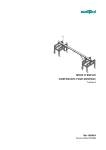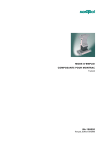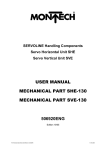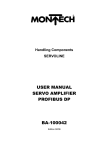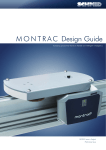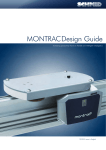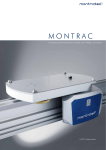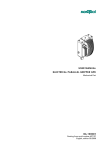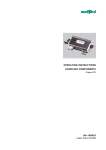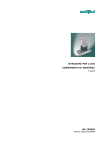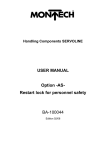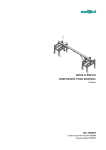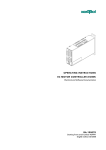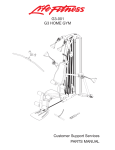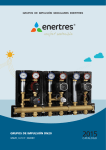Download USER MANUAL MONTRAC COMPONENTS BA-100049
Transcript
USER MANUAL MONTRAC COMPONENTS TracGate 3 BA-100049 english, edition 04/2006 User manual Montrac Components TracGate 3 ® Contents 1 Important information ____________________________________________________________ 3 1.1 Introduction______________________________________________________________________ 3 1.2 EU - conformance (to EU Directive on Machines, Appendix II A) ________________________ 3 1.3 EMV-Richtlinien __________________________________________________________________ 3 1.4 Product description and application_________________________________________________ 3 1.5 Safety instructions ________________________________________________________________ 4 1.6 Additional information ____________________________________________________________ 4 1.7 Validity of the User Manual ________________________________________________________ 5 1.8 System logistics __________________________________________________________________ 5 2 Technical Data ___________________________________________________________________ 6 2.1 Technical Data ___________________________________________________________________ 6 2.2 Loading limits ____________________________________________________________________ 6 2.3 Dangers _________________________________________________________________________ 6 2.4 Installation _______________________________________________________________________ 6 2.5 Mechanical connection ____________________________________________________________ 7 2.6 Electrical connection ______________________________________________________________ 7 2.7 Discharge of the electrostatic charge _______________________________________________ 7 3 Settings _________________________________________________________________________ 8 3.1 Setting the Trac transitions ________________________________________________________ 8 3.2 Setting the locking system _________________________________________________________ 8 3.3 Setting the end stops _____________________________________________________________ 9 4 Maintenance____________________________________________________________________ 10 4.1 Checking the electrical Trac connection ____________________________________________ 10 4.2 Checking the distaance___________________________________________________________ 10 4.3 Checking the current-carrying rails_________________________________________________ 10 4.4 Checking the play of the pivot point _______________________________________________ 10 4.5 Checking the locking system ______________________________________________________ 10 1 User manual Montrac Components TracGate 3 ® 4.6 Cleaning and oiling the start element ______________________________________________ 10 4.7 Checking the sensor _____________________________________________________________ 10 4.8 General check __________________________________________________________________ 11 5 Overview ______________________________________________________________________ 12 5.1 Trac Gate double________________________________________________________________ 12 5.2 Trac Gate single_________________________________________________________________ 12 6 Device _________________________________________________________________________ 13 6.1 Trac Gate double________________________________________________________________ 13 6.2 Trac Gate single_________________________________________________________________ 14 6.3 Quickset – Unterbauten __________________________________________________________ 15 7 Environmental compatibility and disposal_________________________________________ 16 8 List of figures __________________________________________________________________ 17 2 User manual Montrac Components TracGate 3 1 1.1 ® Important information Introduction This operating instruction describes the mechanical design, the load limits, installation, maintenance and spare parts of the TracGate. 1.2 EU - conformance (to EU Directive on Machines, Appendix II A) Regulations and standards taken into account: A Montrac transport system is a machine that consists of, depending on the application, a variety of precisely defined components. The regulations and standards taken into account for the components are mentioned in the respective sub-chapter of the operating instructions. Montrac transport systems may only be put into operation, – when they are operated with a power supply that complies with the standards described in the operating instructions. – when the space beneath transfer gates and crossings is inaccessible in an area with a diameter of 1.6 m (Danger of crash for shuttles if transfer gate or crossing is incorrectly switched.) Manufacturer Montech AG, Gewerbestrasse 12 CH–4552 Derendingen Tel. +41 32 681 55 00, Fax +41 32 682 19 77 1.3 EMV-Richtlinien Emission: EMC directives: Noise field intensity according to EN 55011 or EN 55022, Class A. Immunity: To electromagnetic fields according to 801-3: 10 V/m, 1 kHz, 80% AM. To burst according to IEC 801-4: 2 kV. To line-carried, narrow-band noise according to IEC 801-6: 10 VEMF. To 50 Hz magnetic fields according to EN 61000-4-8: 30 A/m. To discharge of static electricity. To conducted noise. 1.4 Product description and application Montrac is a monorail transport system with self-propelling shuttles, constructed to carry loads of up to 12 kg or 24 kg (2-axle shuttle) and pallet sizes up to 300 x 550 mm. Montrac is a modular system. Standardized basic components enable customer-specific system configurations to be set up for connection to machining stations, machines, order-picking stations, etc. 3 User manual Montrac Components TracGate 3 ® Montrac can be used wherever material has to be moved, distributed, processed stepwise (e.g. assembled) or collected together at one point from various senders. 1.5 Safety instructions The safety instructions, especially those concerning the electrical connection, must be heeded during commissioning, operation, repair work and decommissioning. Non-compliance with these instructions is an improper use of the transport system and its components. The operation of a Montrac transport system in an explosive atmosphere (combustible gases, vapors or dust) may lead to their ignition and must therefore not be carried out. 1.6 Additional information The aim of the present operating instructions is to enable users to employ TracGate correctly and safely. Should further information be required relating to the particular application, do not hesitate to contact the manufacturer. When ordering user manual it is essential to quote the type and serial number. Additional operating instructions can be obtained from our homepage www.montech.com. Fig. 1-1: Nameplate R Barcode CH-4552 DERENDINGEN GERWERBESTRASSE 12 *48865 102357.002* Order number Serial number MONTECH AG Management U. D. Wagner 4 C. Wullschleger User manual Montrac Components TracGate 3 1.7 ® Validity of the User Manual Our products are continually updated to reflect the latest state of the art and practical experience. In line with product developments, our User Manuals are continually updated. Every User Manual has an article number e.g. BA-100049. The article number and the date of edition are evident on the title page. 1.8 System logistics The Trac Gate is intended to permit passage through a Montrac line or access to manual workplaces within the line. It is an automatic device and thus has its own supporting structures. Through passage is permitted for one person as a minimum and for a small fork-lift truck as a maximum (2 versions). The principle of Trac Gate is very simple. The gate is fixed at a pivot point and can be manually opened and rotated in the opening direction up to a rubber peg with a magnet. On closing, the gate is rotated up to an end stop and can then be manually locked again. If a person wishes to pass through the Trac Gate, he or she must first log on beforehand on the logon/logoff button. The release lamp flashes. The shuttles are stopped and, as soon as the gate is free, it is then released for passage (lamp lights up continuously). It can then be opened manually. After passing through, the person must close the gate again manually, lock it by means of the lock and log off on the logon/logoff button so that the shuttles are started again. 5 User manual Montrac Components TracGate 3 2 2.1 ® Technical Data Technical Data Length tolerance of the Trac Gate ± 2.0 mm Material Aluminium, copper, plastic Connected voltage 24 V DC Ambient conditions: Permissible temp. range 10 - 40 ° Purity of the air Relative humidity 2.2 Atmosphere for the assembly of precision engineering products ≤ 90% without condensation Loading limits Electrical loadability between the Trac connections 64 A on the movable Trac section 5A Mechanical loadability 340 N* * corresponds to the force of a fully loaded two-axis shuttle. 2.3 Dangers In order to exclude dangers under operating conditions, the requirements specified in the EU Declaration of Conformity with regard to a) the electrical supply and b) the safety equipment must be fulfilled. For setup or test purposes, particular attention must be paid to the shear and crushing points. During operation, the Trac Gate must be screwed to the floor or appropriately secured. When mounting the Trac Gate on the supporting structure, it must be ensured that the supporting structure is secured beforehand. 2.4 Installation The Trac Gate must be connected in three ways to the system components to be connected to it: – Mechanical connection – Electrical connection – Discharge of the electrostatic charge 6 User manual Montrac Components TracGate 3 2.5 ® Mechanical connection This connetion is performed at the two rail sections by means of Trac connections (Art. No. 56056, see user manual "TracLink"). It should be ensured that the rail sections are exactly flush with the system components (e.g. Tracs) to be connected. Lateral alignment errors of more than 0.5 mm lead to inexact transitions between the rail sections within the Trac Gate. It should also be ensured that the rail sections are exactly flush with the system components (e.g. Tracs) to be connected, also in the vertical direction. This should be corrected by means of the feet of the supporting structure. Vertical alignment errors of more than 0.5 mm lead to inexact transitions between the rail sections within the Trac Gate. 2.6 Electrical connection The electrical connection of the connection tracs to the system components to be connected to them is implemented as described in the section entitled "Trac", subsection "Installation – dilatable connection". Since the Trac Gate represents an opening in the system (also in the electrical circuit), an electrical bridge must be produced between the ends of the connection tracs. The connections of this bridge are connected to the two Trac connections (Art. No. 56056, see user manual "TracLink") at the ends of the connection Tracs. 2.7 Discharge of the electrostatic charge When connecting the Trac Gate to the incoming or departing system components (e.g. Tracs) by means of a Trac connection (Art. No. 56056, see user manual "TracLink"), it is essential to ensure that each rail section is connected with an earthing cable "Trac earth" and with a screw. 7 User manual Montrac Components TracGate 3 3 3.1 ® Settings Setting the Trac transitions The transitions between the movable gate and the connecting tracs may have an offset of max. 0.5mm in the region of the running surfaces. The following procedure must be followed when setting the transitions: – The gate is fastened to the supporting structure by means of the SLL mounted on the guide and can thus be subsequently adjusted in the vertical and horizontal directions relative to the connection trac. – Once the gate is flush with the connection trac, the screws of the SLL are each tightened with 6 Nm. – In order to adjust the gap between gate and connection trac, the SLL of the spacer tube and the corner connector EV3/45° must be loosened. – The gate can then be moved in the longitudinal direction so that the gap is min. 0.5 mm and max. 0.8 mm. – Once the gate has been adjusted, both connections must be tightened again, each with 6 Nm. – In order to adjust the Trac transition on the side of the locking system, all that is necessary is to loosen the SLL of the bracket. – The gate is pretensioned by means of the strut so that the transition is no more than 0.5 mm. The screws of the SLL can then be tightened again, each with 6 Nm. – The gap on the side of the locking system, i.e. between the two supporting structures can be adjusted to min. 0.5 mm and max. 1.0 mm by moving the supporting structure. 3.2 Setting the locking system – Any alignment errors between gate / gate or gate / connection trac can be compensated by means of the locking system. – Slightly slacken all screws of the locking system. – Compensate alignment errors in the horizontal direction (vertical alignment errors cannot be compensated with the locking system and tighten screws again). 8 User manual Montrac Components TracGate 3 3.3 ® Setting the end stops – The open end stop must be moved up or down, until the rubber cushions are in the middle of the gate support. – If the installation angle of the end stop is not correct, the end stop must be clamped into the spacer using a screw clamp. After that, slightly loosen the screws of the corner connector of the guide and align the gate with the inward or outward transfer Trac. Then retighten screws with a torque of 6 Nm. 9 User manual Montrac Components TracGate 3 4 ® Maintenance Every 6 months 4.1 Checking the electrical Trac connection By slight pressure on the current-carrying rails at the transitions, it is possible to determine whether the electrical connection is satisfactory. If the current-carrying rails are springy, the contact pieces on the inside should be tightened according. 4.2 Checking the distaance The distance between two Trac sections should be checked and should be tightened according to Section 3.1. 4.3 Checking the current-carrying rails With a dry cloth, wipe the nickel-plated bus bars to remove rough dirt and dust. 4.4 Checking the play of the pivot point If a noticeable play of > 1 mm is present when the gate is moved vertically, this can be adjusted again by tightening the two nuts on the bracket of the guide so that the gate is still easily rotatable without marked play. 4.5 Checking the locking system In the locking system, the pin must be checked. If it can be moved easily, the springy thrust piece must be adjusted so that locking in the end positions is readily detectable on moving the pin. Prior to each readjustment, apply threadlocker to the pressure pad. If the pin has scratches, it must be changed using the hand lever. 4.6 Cleaning and oiling the start element The pistons of the start elements should be cleaned and should be lubricated with Paraliq P460 or special grease for pneumatic pistons (for start elements, see section on accessories). 4.7 Checking the sensor Check the sensor in the locking system for damage (for example, mechanical wear of the sensor cap). Replace damaged sensors. Also check the position of the sensor. In addition, secure the sensor with a locknut. 10 User manual Montrac Components TracGate 3 ® Cleaning the Trac The Trac should be freed from excessive dirt and from oils and greases. Remove coarse dirt and dust with a dry cloth. Dirt on the Trac is best removed using the aluminium rubber. The resulting abraded rubber material should be removed from the Trac. 4.8 General check The Trac should be checked for damage. In the event of damage, please contact MONTECH. 11 User manual Montrac Components TracGate 3 5 5.1 ® Overview Trac Gate double Installation length 3000mm Fig. 5-1: Installation length 3000mm Art.Nr. 55001 5.2 Trac Gate single Installation length 2000mm Fig. 5-2: Installation length 2000mm Running direction inside outside pivot (left) 12 Art.Nr. 55011 User manual Montrac Components TracGate 3 6 6.1 ® Device Trac Gate double Installation length 3000mm Fig. 6-1: Installation length 3000mm Item Art.Nr. Designation Trac Gate Art. Nr. 10 55024 Inward transfer Trac long, copper inside 55001 10 55025 Inward transfer Trac long, copper outside 55001 20 55040 Gate complete, copper left 55001 30 55041 Gate complete, copper right 55001 40 55032 Outward transfer Trac long, copper inside 55001 40 55033 Outward transfer Trac long, copper outside 55001 50 92068 Guide 55001 60 92069 End stop open 55001 70 92070 End stop close 55001 80 92071 Locking system complete 55001 90 92072 Release lamp 55001 100 92073 Logon / logoff button complete 55001 110 92079 Gate support 55001 13 User manual Montrac Components TracGate 3 6.2 ® Trac Gate single Installation length 2000mm Fig. 6-2: Installation length 2000mm Item Art.Nr. Designation Trac Gate Art.Nr. 10 55024 Inward transfer Trac long, copper inside 55011 10 55025 Inward transfer Trac long, copper outside 55011 10 55028 Inward transfer Trac with thread, long, copper inside 55011 10 55029 Inward transfer Trac with thread, long, copper outside 55011 20 55040 Gate complete, copper left 55011 20 55041 Gate complete, copper right 55011 40 55032 Outward transfer Trac long, copper inside 55011 40 55033 Outward transfer Trac long, copper outside 55011 40 55036 Outward transfer Trac with thread, long, copper inside 55011 40 55037 Outward transfer Trac with thread, long, copper outside 55011 50 92068 Guide 55011 60 92069 End stop open 55011 70 92070 End stop close 55011 80 92071 Locking system complete 55011 90 92072 Release lamp 55011 100 92073 Logon / logoff button complete 55011 110 92079 Gate support 55011 14 User manual Montrac Components TracGate 3 6.3 ® Quickset – Unterbauten The Quickset – Supporting structures are not included for the Trac Gates. Overview Art.Nr. 92064-0900 Art.Nr. 92066-0900 1) Trac Gate Double, 3000mm 2x Double, 2540mm Single, 2000mm 1x 1x Single, 1605mm 1) This Quick-Set supporting structures is to install on the side of the lock. The “-0900“ in the article number refers to the working height or platform upper surface (Fig. 6.3). The standard height is 900 mm. However, this can be adapted to customer requirements. L=900 Fig. 6-3: Quick-Set height 15 User manual Montrac Components TracGate 3 7 ® Environmental compatibility and disposal Materials used – Aluminium – Copper – Brass – Steel – Bronze – Polyethylene (PE) – Polyamide (PA) – Polyurethane (PUR) – Polyvinyl chloride (PVC) – Polycarbonate (PC) Surface treatment – Anodization of aluminium – Nickel-plating of brass and steel – Galvanizing of steel Shaping processes – Extrusion of aluminium – Machining of aluminium, steel, bronze, PE, PA – Casting of aluminium Emissions during operation – See EMC emissions Disposal Trac Gates which cannot be used any more should be recycled not as complete units but after dismantling into individual parts, according to type of material. The type of material for each part is shown in the spare parts lists. Material which cannot be recycled should be appropriately disposed of. 16 User manual Montrac Components TracGate 3 8 ® List of figures Fig. 1-1: Nameplate _____________________________________________________________________4 Fig. 5-1: Installation length 3000mm ____________________________________________________ 12 Fig. 5-2: Installation length 2000mm ____________________________________________________ 12 Fig. 6-1: Installation length 3000mm ____________________________________________________ 13 Fig. 6-2: Installation length 2000mm ____________________________________________________ 14 Fig. 6-3: Quick-Set height______________________________________________________________ 15 17


















